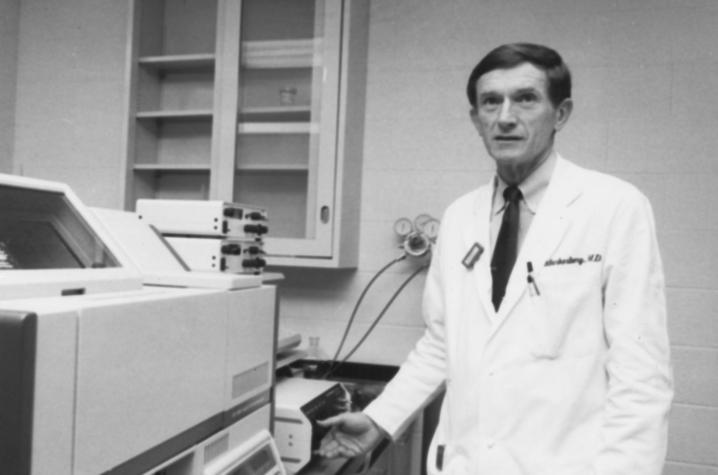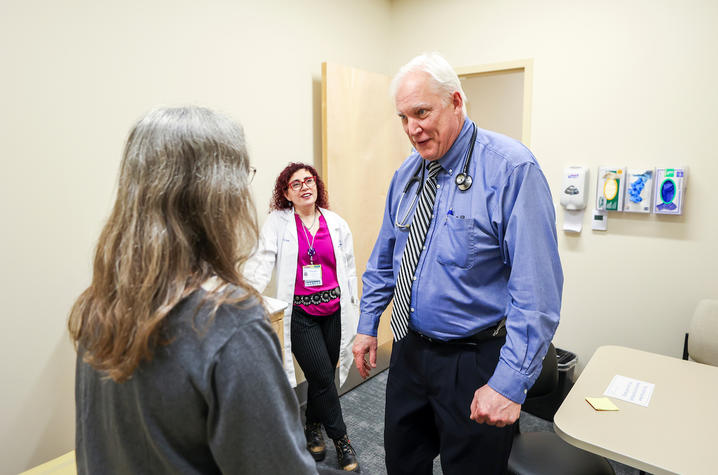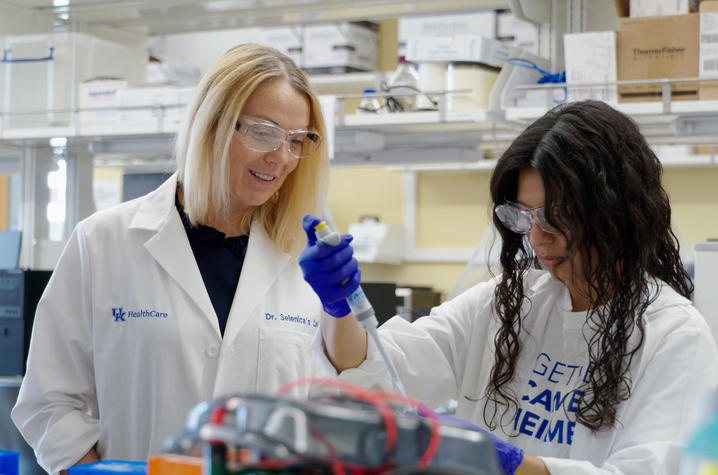Breaking barriers in brain health: Sanders-Brown’s 40-year legacy of Alzheimer’s research
LEXINGTON, Ky. (May 14, 2025) — For the past four decades, the University of Kentucky’s Sanders-Brown Center on Aging (SBCoA) has been at the forefront of Alzheimer’s disease research, making groundbreaking discoveries that have shaped our understanding of this complex condition.
As one of the nation’s elite Alzheimer’s Disease Research Centers (ADRCs), SBCoA has played a crucial role in advancing scientific knowledge, improving patient care and fostering hope for millions of families affected by dementia.
Center Director Linda Van Eldik, Ph.D., and others recently described the impact of the ADRC’s 40 years in an article published in Alzheimer’s & Dementia: The Journal of the Alzheimer’s Association.
A legacy of leadership and discovery
Established in 1979, SBCoA quickly became a leader in aging research, earning a prestigious designation as an ADRC from the National Institute on Aging in 1985 — one of the first 10 in the country. This recognition placed the center among a select group of institutions dedicated to unraveling the mysteries of Alzheimer’s disease.
Since its inception, Sanders-Brown researchers have contributed significantly to understanding the biological processes underlying Alzheimer’s. Early studies from the center helped characterize the roles of amyloid plaques and tau tangles in disease progression, forming the foundation for much of today’s research. Additionally, SBCoA has been instrumental in identifying how genetic risk factors, such as the APOE ε4 allele, contribute to an individual’s susceptibility to developing the disease.
“The UK-ADRC has been at the heart of Alzheimer’s research for 40 years, making discoveries that have changed how we diagnose, treat and even think about this disease,” said Van Eldik. “Our goal has always been to turn research into real-world solutions that improve lives.”
Advancing early detection and diagnosis
One of the center’s most significant contributions has been its research on early detection. Researchers at SBCoA have developed innovative diagnostic tools, including advanced brain imaging techniques and biomarker studies, to identify Alzheimer’s disease at its earliest stages — often before symptoms even appear. These efforts have helped pave the way for earlier interventions and more effective treatment strategies.
One of the hallmarks of Sanders-Brown’s research is its long-term observational studies, tracking aging adults over many years to understand the earliest changes associated with cognitive decline. These studies have provided critical insights into how the disease develops, leading to breakthroughs in early detection methods, including blood-based biomarkers, cerebrospinal fluid (CSF) analysis, and MRI and other imaging techniques.
“The ability to detect Alzheimer’s earlier means we can intervene sooner, potentially slowing its progression and giving individuals and families more time and better outcomes,” Van Eldik said. “Every step forward in early diagnosis brings us closer to effective prevention strategies.”
Transforming clinical care and community impact
Beyond research, SBCoA has been deeply committed to patient care and community engagement. The center provides comprehensive clinical services for individuals with Alzheimer’s and other neurodegenerative diseases, offering diagnostic evaluations, treatment plans and support for caregivers.
SBCoA’s outreach initiatives have had a profound impact on public awareness and education. Through partnerships with local organizations, the center conducts workshops, support groups and educational programs that empower families and health care providers with the latest information about Alzheimer’s.
Additionally, SBCoA has worked tirelessly to address health challenges in Kentucky, ensuring that individuals at high risk for dementia have access to high-quality dementia care and research opportunities.
“At Sanders-Brown, we believe research should not stay in the lab — it should reach the people who need it most,” said Van Eldik. “Our commitment to community engagement ensures that families across Kentucky and beyond have access to the best information and care available.”
Leading the charge in clinical trials
SBCoA has also been instrumental in advancing clinical trials for Alzheimer’s treatments. Over the years, the center has played a key role in testing promising new drugs aimed at slowing or even preventing the progression of the disease. Researchers at Sanders-Brown have contributed to major trials evaluating the efficacy of monoclonal antibodies targeting amyloid and tau proteins, including recent FDA-approved treatments such as lecanemab and donanemab.
Beyond pharmaceuticals, SBCoA has led research into nondrug interventions, exploring how lifestyle factors such as diet, exercise and cognitive training can influence brain health and potentially reduce the risk of developing Alzheimer’s. These studies have reinforced the importance of holistic approaches to dementia prevention and care.
“Every clinical trial we conduct brings us closer to real breakthroughs,” said Van Eldik. “Our team is committed to ensuring that the most promising treatments and strategies reach patients as quickly and safely as possible.”
Looking to the future
As the Sanders-Brown Center on Aging enters its fifth decade, its commitment to fighting Alzheimer’s remains stronger than ever. With ongoing research into new treatments, lifestyle interventions and the genetic foundations of dementia, SBCoA continues to push the boundaries of what is possible.
New initiatives include precision medicine approaches tailored to individual genetic and biomarker profiles, as well as efforts to develop a deeper understanding of how inflammation and vascular health contribute to cognitive decline. Researchers at Sanders-Brown are also exploring cutting-edge technologies, such as artificial intelligence and machine learning, to improve diagnosis and track disease progression more accurately.
The future holds great promise, and thanks to the dedication of the scientists, clinicians and community partners, Sanders-Brown is closer than ever to unlocking new ways to prevent and treat Alzheimer’s disease.
For 40 years, UK’s Alzheimer’s Disease Research Center has strived to be a beacon of hope in the fight against Alzheimer’s, Van Eldik said. Through relentless research, groundbreaking discoveries and unwavering commitment to patients and families, the center has changed the landscape of dementia care and continues to pave the way toward a brighter future.
“The future of Alzheimer’s research is incredibly promising,” he said. “With the amazing team at Sanders-Brown and our dedicated collaborators and partners, we are more hopeful than ever that we can change the trajectory of this disease.”
Research reported in this publication was supported by the National Institute on Aging of the National Institutes of Health under Award Number P30AG072946. The content is solely the responsibility of the authors and does not necessarily represent the official views of the National Institutes of Health.
As the state’s flagship, land-grant institution, the University of Kentucky exists to advance the Commonwealth. We do that by preparing the next generation of leaders — placing students at the heart of everything we do — and transforming the lives of Kentuckians through education, research and creative work, service and health care. We pride ourselves on being a catalyst for breakthroughs and a force for healing, a place where ingenuity unfolds. It's all made possible by our people — visionaries, disruptors and pioneers — who make up 200 academic programs, a $476.5 million research and development enterprise and a world-class medical center, all on one campus.








